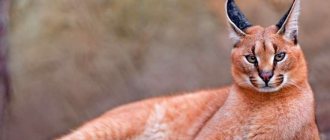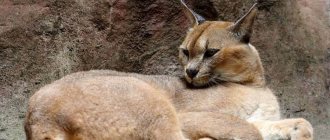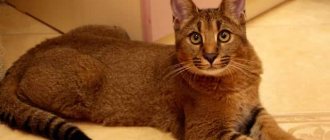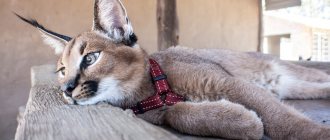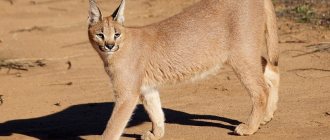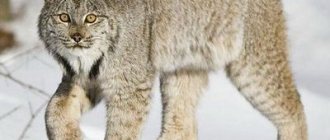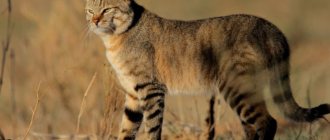- Posted by Olga Arkhipova
- Date: March 21, 2018
Caracals are predators of the cat family, distinguished by long black tufts on their ears. These are very capricious and demanding animals. However, with proper care and caring attitude, desert cats will become loyal and devoted friends to their owners.
- 2 Where does the caracal live
2.1 Video: caracal
- 3.1 Video: caracal hunting
- 4.1 Video: caracal at home
Why was the caracal called that?
Fast and hardy animals, caracals are distinguished by their unusual appearance due to the long dark tufts of hair on their ears. The literal translation of the name of these representatives of the cat family from Turkish means “black ears.” Externally, caracals are similar to the common lynx. Common features of these animals include wide paws and round pupils. But, unlike the lynx, the steppe cat has a long tail.
Caracal is the closest relative of the common lynx
Other characteristic features of the caracal's appearance are:
- slim body weighing no more than 20–24 kg;
- compact dimensions of the body - the height at the withers is on average 40 cm, and the body length reaches a maximum of 100 cm;
- long tail - in adult individuals, the size of this part of the body varies from 24 to 31 cm;
- short coat with a thick undercoat, moderately hard to the touch;
- a small graceful head with an elongated muzzle, on which patches of black fur are noticeable on the sides and near the eye sockets;
- elongated paws, capable of overcoming sand dunes thanks to the hard bristles on the outside of the hands;
- a short mustache next to a large black nose, the latter highlighted by pinkish pigment in the central part;
- high (up to 4–5 cm) pointed ears with long black sickle-shaped tassels;
- monochromatic color with a predominance of sandy shades (from light beige to reddish), alternating with white (on the belly, throat, chin and inside the ears) and black (outer part of the ears) fur.
Otherwise, caracals are called desert or steppe lynxes. This is due to the animal’s distribution area - the deserted shores of the Caspian and Red Seas, the steppes of Turkmenistan and Dagestan, the plateaus of Turkey and Iran.
In former times, such predators were not uncommon in those parts and were tamed to hunt small ungulates and hares.
To this day, African caracals do not need protection, which cannot be said about their Asian counterparts. The latter are reducing their numbers every year, which is why they were listed in the Red Book.
origin of name
Now that the reader knows about the appearance of the caracal and the place where it lives, he may be interested in where such a strange name came from. In fact, everything is simple here.
The name came into the Russian language from the Turkic languages - Turkish, Kyrgyz, Kazakh. Now it is difficult to say exactly which people gave the usual name to this beast. After all, from all of the above languages, “karakulak” is translated as “black-eared” or “black ear” - as mentioned above, the outer side of the ears of a sand animal is precisely black in color. Apparently, Russian settlers or soldiers simply simplified it to the more easily pronounced caracal.
Moreover, this word has taken root not only in the Russian language, but also in almost all European languages. After all, even in Latin the beast is called nothing more than caracal.
Where does the caracal live?
Despite the telling name, these cats can be found not only among sand dunes and steppe feather grasses. Caracals live in forests and foothills. A flexible body and elastic paws allow steppe lynxes to deftly climb trees. From there you have a wide view of the conquered territories. By the way, their area can reach 340 km2 or more.
Caracals, like other cats, deftly climb trees.
To rest, the caracal prefers to look for holes or crevices in the rocks abandoned by other animals. If the animal likes the place, the desert lynx will return to such a refuge for many years.
It is noteworthy that males and females live separately, meeting only during mating and having offspring.
By nature, these animals are loners. Having reached sexual maturity in the first year of life, the caracal leaves its fellows to conquer its own territory.
Video: caracal
Number of species
In some areas of Africa, there are many caracals, so they are considered a common animal there. A wild cat can cause harm to farms and farms, so it is hunted as a pest. Such deliberate extermination of representatives of the species caused a decline in numbers.
one of the caracal subspecies may become extinct
There are very few caracals left in Central Asia. One of the subspecies (Caracal caracal michaelis) living in Turkmenistan is considered endangered. There are no more than 300 individuals of this subspecies left. The subspecies is listed in Appendix II of CITES (the list of animal species covered by the Convention on International Trade in Endangered Species of Wild Fauna).
The caracal is a species of mammalian predator of the cat family. They are called wild steppe cats and desert lynxes. They inhabit savannas and steppes, lead a solitary lifestyle and hunt small animals. Caracals are similar to cheetahs and lynxes. They also deftly climb trees and jump far. However, they themselves can become victims of predators. Caracals can be tamed. To do this, you need to equip an enclosure. In captivity, wild cats must be fed meat. In order for the desert lynx to live long and be healthy, it needs good care and the participation of a veterinarian.
Lifestyle of the steppe lynx
The life of a wild caracal kitten begins after 75–80 days of the female's pregnancy. As a rule, there are no more than three cubs in a litter. The litter is born blind, and only two weeks later the kittens begin to see. Until this moment, the female jealously guards the offspring, hidden in a gorge or an abandoned hollow of a fallen tree.
Female steppe lynx are caring and zealous mothers
The color of caracal cubs differs from the appearance of adult individuals due to the large number of dark specks on their fur. Over time, only the muzzle remains spotted.
A month after birth, the kittens begin to develop the territory near the den, and after another month the female transfers the babies to solid food.
Regarding the latter, it is worth noting the following:
- Caracals feed mainly on small rodents and birds like guinea fowl;
- Steppe lynxes forage for food at night;
- These animals hunt, reaching prey with the help of large jumps (up to 5 meters in length) or waiting at watering holes;
- These cats make caches of food high in the trees.
Since the animal is accustomed to life in arid areas, the caracal can go without drinking for a long time - for up to ten days, this cat is able to obtain liquid only from food. In this case, the diet of the desert lynx is expanded by including grass and berries (for example, grapes) in the menu.
Caracals are dexterous and intelligent predators, skillfully camouflaging themselves among thickets of bushes. So these animals have few enemies. The main threat comes from birds of prey during the period of raising their offspring. And for adult individuals, lions and hyenas become enemies if the animal lives in African savannas, or steppe wolves and alabai guarding sheep (when it comes to Kazakh or Turkmen steppe lynxes).
Hunting for caracal is prohibited in the countries of the former USSR, since the species is on the verge of extinction. At the same time, these animals do not take root in zoos. Therefore, nature reserves and sanctuaries are organized in the habitats of desert lynxes.
However, local residents often engage in poaching of steppe lynx due to the threat of a reduction in livestock numbers.
Video: caracal hunting
History of the breed
The desert lynx is easy to tame. Thus, the ancient Turks and Kazakhs from the poor classes took a tamed caracal with them to hunt, using it to catch hares, antelopes, and birds. Over time, the fashion for such hunting fell away. Thus, the need to tame the desert lynx also disappeared.
Until the 80s of the last century, representatives of the Caracal cat breed were found only in the wild and zoos. At the Moscow Zoo, an ordinary cat once wandered into the enclosure of a desert lynx, and then gave birth to a kitten of an unusually beautiful color. In addition, small tassels hung from the ears of the newborn purr.
The news of an accidental interspecific crossing, which was crowned with success, quickly spread throughout felinological circles. Breeders began to breed another breed of cats.
Meanwhile, over time, the popularity of Caracal cats - beautiful animals that are not difficult to tame - has sharply increased among exotic lovers.
A cross between caracals and domestic cats has been officially registered as the caraquet breed.
How to keep a pet caracal
Before getting such an exotic pet, you need to take care of creating acceptable living conditions for a caracal in a country house or city apartment.
Caracals have been tamed by people since time immemorial.
First you need to allocate a place for the wild cat to live. The enclosure must be spacious - at least 20 m2. A scratching post and other accessories necessary for animal play must be installed inside - logs, steps, shelves. If the owner of the caracal lives in an apartment, you need to take care of regular and long-term walking of the animal. After all, desert lynxes are very active cats that need to run and jump.
It is important to remember that it is not recommended to keep the steppe lynx in a house where there are small children. Despite its docile nature, the caracal remains a wild animal with an unpredictable reaction.
Caring for a caracal requires compliance with a number of rules:
- You need to wash your pet as rarely as possible so as not to damage the skin and fur coat;
- The ears and eyes should be checked regularly for contamination;
- The animal’s fur must be combed at least once every seven days;
- It is recommended to remove claws on the front paws using laser technology, and it is better to carry out the procedure in a nursery before purchasing.
To maintain the health of such an exotic pet at the proper level, it is important to properly organize the caracal’s nutrition.
A balanced menu for a domestic desert lynx should include:
- meat dishes - poultry, rabbits, beef;
- fish dishes, including fillets of sea fish at least once every five to seven days;
- raw chicken eggs no more than once every seven days;
- seasonal fresh grass or dry food in winter.
You cannot feed the caracal pork and salty food; sausages and confectionery are prohibited.
For kittens under three years of age, calcium supplements and other vitamin and mineral complexes will be a good addition, which should be selected individually after examination by a veterinarian.
In order to maintain the normal state of the intestinal microflora, once a week you need to add food familiar to predators to the diet of the steppe lynx - small rodents, uncut bird carcasses.
The feeding regimen involves two meals a day. And for males it is recommended to have a “fasting day” every two weeks. During this time, the animal must fast, having access only to water resources. This need is due to the fact that in their natural habitat animals obtain food irregularly, thereby avoiding obesity and other health problems.
The daily portion for an adult caracal is from 350 to 600 g of meat, depending on the age and weight of the pet.
It is also interesting that it is better to give food to the steppe lynx every day at different times, so that it does not get used to the feeding schedule.
Video: caracal at home
Descendant of wild ancestors - Norwegian cat
A Norwegian cat can be an excellent option for a city apartment. This playful, active pet will become a favorite among all family members. Smart, unpretentious pets are distinguished by their affectionate, kind nature and patience, allowing them to endure the pestering of small children.
[advertising-text]
The main characteristics of the Norwegian cat include:
- tassels on the tips of the ears;
- thick coat;
- fluffy tail;
- long limbs;
- the head is triangular in shape.
Pets do not require complex care; you only need to regularly comb their hair, trim their claws and clean their ears. The Norwegian cat eats natural products (except smoked meats and pork) and premium category dry food. (read more about the Norwegian forest - here)
Caring for the health of the steppe lynx at home
Domestic caracals are easy to care for and have excellent immunity. Animals rarely get sick if their owners take proper care.
Regular examination by a veterinarian is the key to the health and longevity of a domestic caracal.
The main health problem may be Aueszky's disease, characterized by the appearance of itchy lesions on the animal's skin and a disorder of nerve endings. Such an illness is possible in case of irregularities in the diet, when the animal is fed pork.
If the owner carefully complies with the requirements for keeping and caring for the steppe lynx, regularly administers vaccinations and visits the veterinarian with the pet, then there will be no problems with the well-being of such a wild cat.
The first vaccination is given to caracals at the age of 3 months, followed by revaccination 30 days later. Pets are also vaccinated against rabies. Vaccines for steppe lynxes living with humans include panleukemia, rhinotracheitis and calcevirosis.
Routine visits to the veterinary clinic should be carried out twice a year.
Inspection should be carried out regularly, despite the animal’s good health. This is also due to the fact that caracals can be carriers of chlamydia, although such an ailment may not manifest itself outwardly.
Caracals are considered long-lived among other representatives of the cat family. The average lifespan of an animal is at least 12–14 years.
American Bobtail
This is a relatively new breed that appeared in the States in the 60s of the 20th century. From childhood, kittens look like little lynxes: they are born with short tails and fluffy wings on their cheeks. The spotted or striped color gives it an additional resemblance to a lynx. The American Bobtail has hind legs that are slightly longer than the front legs, like a lynx. Therefore, even the gait resembles a trot. Despite all this, the American Bobtail is a very gentle and domestic creature.
Peculiarities:
- Height up to 30 cm, weight up to 6 kg;
- Quickly find a common language with people, cats, dogs;
- They become attached to a person;
- They tolerate moving well and adapt quickly;
- Price from 10,000 rub.
American Bobtail
Habits of the domestic caracal
Owners love steppe lynxes for their playful nature and calm disposition. These animals are easy to train and easily come to an understanding with all family members and other pets.
Caracals are very playful and active pets.
If you do not create unbearable conditions for the animal in the form of limited space and bad attitude (these predators cannot tolerate high tones in conversation and physical influence), then the desert lynx will become a devoted and affectionate friend.
Since the animal has irrepressible energy, if there is no proper approach to education, it can regularly misbehave and plunge the living space into chaos. To cope with a wild animal at home without much effort, you need to teach your cat the correct manners from an early age:
- make demands as clear and consistent as possible;
- establish acceptable behavioral standards and limits.
Behavioral problems can await owners of pet steppe lynxes with young pets. After reaching the age of two, caracals become more flexible and balanced.
In addition, in order to avoid manifestations of aggression and leaving specific marks on household items, before the pet reaches puberty, it is better to castrate the male (up to 5 months) and sterilize the female (at 9 months).
In character, caracals resemble dogs, because these animals also love to run and play with a ball. Steppe lynxes are also well accustomed to a leash.
For toys, it is better for an exotic cat to choose dog accessories or children's toys. After all, such items intended for ordinary cats are not suitable for caracals due to their small size.
Character and education
When purchasing a caracal desert lynx for themselves, cat lovers should remember that a predator always remains, first and foremost, a predator.
When raising such a pet, you need to be extremely consistent, specifically put forward your conditions, slowly accustoming the new “family member” to subordination, as well as appropriate behavior in your home.
The desert lynx is distinguished by the following character traits.
- Phlegmatic calm.
- Good nature.
- Passion for various games.
- Owner's instinct. If a tamed desert lynx always tries to get along with other pets living together, cats, dogs, parrots, then it will drive away other people's animals that accidentally enter their territory.
- Curiosity. The cat will be the first to run to the threshold, barely hearing footsteps outside the door. She will also immediately rush to the bushes as soon as they move.
Buying a caracal: the main points
Caracals are an expensive pleasure for exotic lovers. After all, one steppe lynx kitten is valued at no less than 400 thousand rubles. The cost depends on several factors - the purpose of the purchase (kittens for breeding are more expensive) and the gender of the animal (seals are cheaper than female cats). The price tag and the area where the desert lynx is bred are also affected.
It is better to purchase a caracal kitten before six months of age, so that the animal can immediately adapt to a new place and family.
It is better to choose an animal from trusted nurseries and do not seek help from dubious “suppliers” without the necessary documentation. In addition to the fact that the desert lynx may turn out to be sick and socially unadapted, such an animal is subject to seizure due to violation of the legislation on the procedure for processing documentation for this species of mammal.
To ensure that the pet is kind and does not show aggression, it is recommended to adopt a steppe lynx in a home-kept nursery, rather than an aviary-type nursery. The best age to buy a caracal is 6 months from birth.
The kitten must constantly be surrounded by people in order to get used to the owner, become tame and obedient. Although it is impossible to give guarantees for a wild animal in this case.
Another factor that helps you get a kind and flexible caracal as a pet will be the choice of the animal’s parents. When a kitten is taken from a couple who grew up in a nursery, the animal will subsequently delight with its playful and inquisitive character. If you purchase a wild baby, you can get an animal poorly adapted for life among people. Because in their natural environment, caracals are unsociable and prefer loneliness to noisy company, jealously guarding the captured territory. There are known cases of steppe lynx attacks on predators and dogs twice the size of these cats.
Before making a choice in favor of a particular kitten, you need to carefully study the animal’s behavior and monitor the little caracal’s attitude towards others. You also need to pay attention to the appearance of the steppe lynx - the cleanliness of the ears and eyes, the healthy appearance of the coat (the fur coat should be shiny and easy to iron).
The main document issued when purchasing a caracal is the animal’s veterinary passport. This paper records the vaccinations given to the desert lynx at the state veterinary clinic.
Reproduction
The female caracal is committed to polygamous relationships: mating can occur with several males. After conception, the male leaves for his territory, and the cat, for 2.5 months, prepares several secluded places for future offspring. Pregnancy lasts up to 80 days.
The baby caracal, usually two, sometimes up to four, stays with its mother for up to a month after lambing and travels with her to survive among other predators, feeding only on milk.
From the age of 1 month to six months, the kitten moves independently and gets accustomed to solid food. With the onset of six months of age, the animal is considered adult and leaves the female.
If there is no desire for offspring, it is better to sterilize the cat at the age of 9 months, as this animal can show aggression and be unpredictable.
What does it eat?
As mentioned above, the caracal is not too picky about food. He is ready to eat almost any prey that he can catch and kill
Therefore, quite often its diet consists of various rodents - gophers, jerboas and gerbils. In some cases, tolai hares may become victims. And if you’re lucky, the caracal can easily cope with small antelopes or goitered gazelles that have strayed from the herd.
However, the diet often includes more exotic prey. For example, caracals do not disdain hedgehogs and reptiles. If there is no prey for a long time, they may well feast on insects. In regions where such prey lives, it may attack a mongoose or a young ostrich.
But caracals do not feed on carrion - the too pungent smell emanating from rotten meat permeates the dense skin of the predator and may well play a bad joke during an ambush hunt. Although, if fresh remains from the recent food of another predator come across, the caracal will not demonstrate excessive disgust.
Human use
However, caracals are used not only as pets.
In some Asian countries, for example, in Persia and India, the desert lynx was used as a hunting animal, going after pheasant, hares, peacocks and small antelope. Moreover, they were kept mainly by poor people - the wealthy gave preference to cheetahs.
And in South America, caracals are kept at some military airfields. Wild birds resting in large flocks on runways cause serious problems for staff. And predators hunt them with pleasure, forcing them to stay away from an inappropriate place.
